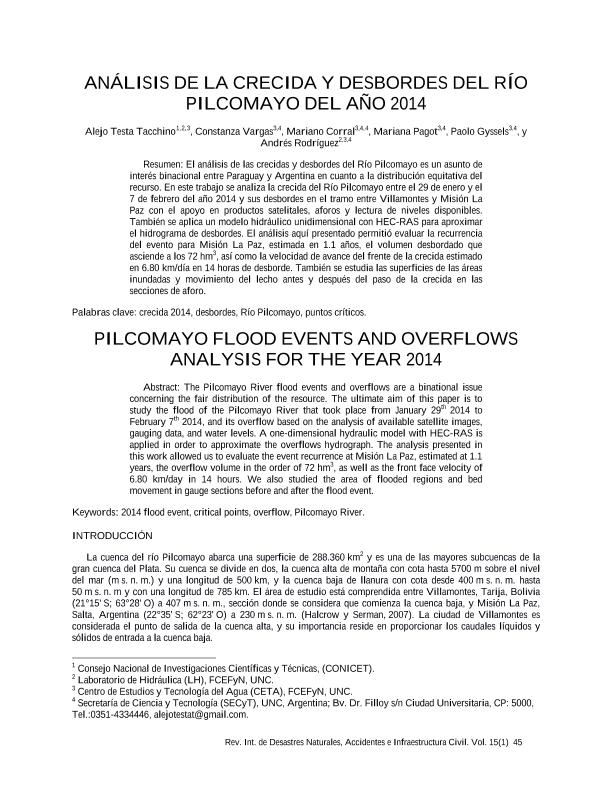Artículo
El Pilcomayo es un sistema fluvial de régimen muy variable y no regulado, con una de las tasas de transporte de sedimentos en suspensión más altas del mundo (125x106 Tn/año). Al salir de su tramo de montaña cercano a la ciudad boliviana de Villamontes, el río se caracteriza por altas tasas de sedimentación las cuales aumentan hacia aguas abajo. Como consecuencia, el río en la cuenca media presenta una geometría de cauce colgado, lo que sumado a su traza meandriforme y la no regulación de sus caudales, propician condiciones de alto riesgo de avulsión, es decir cambio repentino del cauce en su planialtimetría, favorecidas por crecidas donde el flujo desborda en puntos específicos o “puntos críticos”. El río Pilcomayo es estratégico para el desarrollo socioeconómico del Norte Argentino, en particular para las Provincias de Salta y Formosa. La mayor parte de la cuenca activa se encuentra en Bolivia y luego es límite entre Argentina y Paraguay hasta la zona de Embocadura donde las aguas son distribuidas entre ambos países, siguiendo aguas abajo cursos naturales como el Bañado La Estrella y Río Monte Lindo. El objetivo del presente trabajo es presentar una metodología para el análisis y estudio de las crecidas del Río Pilcomayo, así como también presentar su aplicación a la crecida del año 2014. El método se aplica al tramo que va desde Villamontes (Bolivia) hasta Misión La Paz / Pozo Hondo (Argentina / Paraguay), tramo donde se ubican la mayoría de los puntos críticos con riesgo de avulsión. Pilcomayo is a fluvial system with a non regulated and very variable regime. It also has one of the highest suspended sediment load of the world (125x106 Tn/año). After leaving the mountainous reach, downstream Villamontes, the river is characterized by the high sedimentation rate. As a consequence, the river in the middle basin presents a perched channel which added to a meander planform and no regulation of the flow propitiates high risk avulsion conditions, this means flow diverts out of an established river channel into a new permanent course on the adjacent floodplain, maybe caused by a flood with overflow in specific or critical points. The Pilcomayo River is strategic for the development of northern Argentina, especially the provinces of Salta and Formosa. The Pilcomayo River rises and forms its active basin (i.e. where the waters and sediments originate) network, almost totally in the Republic of Bolivia. Further downstream up to the region of “La Embocadura,” it becomes the border between Argentina and Paraguay, where the waters are divided between both countries. The river finally continues its natural course through El Bañado La Estrella AND Río Monte Lindo. The main objective of this work is to present a methodology in order to study flood events in Pilcomayo River as well as to present its application to the flood of January 2014. The method applies to the the reach from Villamontes (Bolivia) to Misión la Paz/Pozo Hondo (Argentina/Paraguay), reach where most of the critics points with avulsion risk are located.
Propuesta metodológica para el análisis de las crecidas del río Pilcomayo y su aplicación para el año 2014
Título:
Methodological proposal for Pilcomayo flood events analisys and the corresponding apllication for year 2014
Testa Tacchino, Alejo Juan Sebastián ; Vargas, Constanza; Corral, Mariano Andres
; Vargas, Constanza; Corral, Mariano Andres ; Pagot, Mariana Renee; Gyssels, Paolo; Rodriguez, Andres
; Pagot, Mariana Renee; Gyssels, Paolo; Rodriguez, Andres
 ; Vargas, Constanza; Corral, Mariano Andres
; Vargas, Constanza; Corral, Mariano Andres ; Pagot, Mariana Renee; Gyssels, Paolo; Rodriguez, Andres
; Pagot, Mariana Renee; Gyssels, Paolo; Rodriguez, Andres
Fecha de publicación:
08/2016
Editorial:
Universidad de Puerto Rico
Revista:
Revista Internacional de Desastres Naturales, Accidentes e Infraestructura Civil
ISSN:
1936-1483
e-ISSN:
1535-0088
Idioma:
Español
Tipo de recurso:
Artículo publicado
Clasificación temática:
Resumen
Palabras clave:
Pilcomayo
,
Desbordes
,
Puntos Críticos
,
Crecida 2014
Archivos asociados
Licencia
Identificadores
Colecciones
Articulos(IDIT)
Articulos de INSTITUTO DE ESTUDIOS AVANZADOS EN INGENIERIA Y TECNOLOGIA
Articulos de INSTITUTO DE ESTUDIOS AVANZADOS EN INGENIERIA Y TECNOLOGIA
Citación
Testa Tacchino, Alejo Juan Sebastián; Vargas, Constanza; Corral, Mariano Andres; Pagot, Mariana Renee; Gyssels, Paolo; et al.; Propuesta metodológica para el análisis de las crecidas del río Pilcomayo y su aplicación para el año 2014; Universidad de Puerto Rico; Revista Internacional de Desastres Naturales, Accidentes e Infraestructura Civil; 15; 1; 8-2016; 45-58
Compartir



